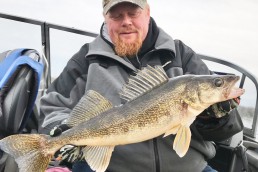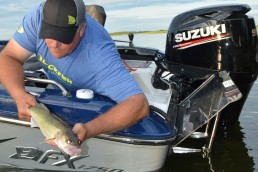Last Open-Water, First-Ice Fishing
SHARE THIS POST
Fall is going to change into winter soon in the “Ice Belt,” which is the part of the US and Canada where lakes freeze thick enough for ice fishing during the winter.
There have been years in my part of northern Minnesota when it gets cold early enough for the lakes to start freezing in the first part of November.
There have been other years when the open water lasted into early December before the lakes started to freeze. The timing of when the seasons change varies greatly, almost like the box of chocolates in the movies: “You never know what you are going to get.”
There aren’t many things left that we can take for granted. One thing we can all count on is that winter is coming and anglers will soon be able to return to the ice for another winter of ice fishing.
In fall, I keep fishing out of my boat as long as it is still practical. I don’t put my boat away until I can drill a hole in the ice. I also like to deer hunt, grouse hunt and there is the Bro Road Show to consider, so like they say, it’s complicated.
Every time I am in my boat late in the open-water season, I am always looking for concentrations of fish and little “spot-on-the-spot” type places that I can use for ice fishing.
The SI feature on my Humminbird Helix 12 lets me look for rocks in all depths, which are areas that attract walleyes, perch and other species much of the year. Sometimes, shallow rocks are the key; other times; deep rocks are better—it depends on the conditions.
The more rocks there are in a lake, the less they matter to the fish. Lakes with an abundance of rocks often have fish favoring areas of sand and mud over rocks. An abundance of rock habitat allows fish to only use the best stuff.
When it comes to habitat, fish often value things that are scarce more than things that are plentiful. When it comes to food, fish value the most plentiful food sources and move from food source to food source during the year, depending on where the largest concentrations of forage are located.
It is up to anglers to unlock the puzzles presented by fishing different lakes for different species. Anglers need to learn the playing field to know what options the fish have to choose from. I start with my electronics when breaking down a lake.
The LakeMaps on my Humminbird Helix 12 G3 N SI show me the lake. I can highlight certain depths and use different color palettes to help make the areas I want to look at stand out better on the map. If it’s a big lake, I will break the lake into sections and treat it like several smaller lakes.
I look at the areas with side-imaging first and mark things I want to take a closer look at by driving directly over the spots with down-imaging and 2D sonar. If I want to go to another level of looking at something, I will take a look with my AquaVu HD7.
Just like summer fishing can be all about covering water, ice fishing is often all about trying to look for small details that make spots unique.
Remember, you are planning to drill a 6- to 10-inch hole in the ice—not drifting a large flat or breakline for miles like anglers do during the summer. It is critically important to be on the right spot for ice fishing. Anglers can be only a few feet away from the groceries and not even know it if they don’t do their homework.
Are you enjoying this post?
You can be among the first to get the latest info on where to go, what to use and how to use it!
Funnel areas or contact points are where fish pass through an area when they move between feeding and resting areas. Fish often use things on the bottom as reference points and move from one feature to another, like following their own versions of road signs.
It’s hard to pinpoint exactly what anglers should be looking for; it’s one of those things that hopefully anglers will know it when they see it. Anything different or unique in an area will usually attract more fish than an area with nothing. It’s like a big aquarium; fish prefer to stay by other things in the aquarium rather than stay in areas with nothing around them.
Fish are both predators and prey for most of their lives. Even if fish are too big to eat, they still act like something is out there that could eat them if it wanted. They are aware of their surroundings as well as their place in the food chain. Fish would rather hide or conceal themselves, even a little bit, rather than feeling like they are out in the open and vulnerable.
Anglers trying to think like a fish can ask themselves, “If I had to find a place to feel safe, where would I go?” Another question is, “If I get hungry, where can I get an easy meal nearby?” These are the spots anglers want to mark for the winter.
Proximity is a huge factor during winter. Most fish that relate to structure prefer a complex area where they can find everything they need. It is similar to finding a good place for Grandma to live: You want everything they need as close as possible.
Complex areas with rocks, deep water, multiple structures, weed patches, steep breaks, points and turns along with a distinct edge between mud and hard bottom would be a place that has almost everything fish could need.
The real world is seldom perfect. Food is the most important thing, whether the fish are eating insects out of the mud or minnows and crayfish located on hard bottom, weed edges or rocks. Match the hatch with Northland Fire Belly Spoons & minnow heads, or a full minnow on a red #4 Gamakatsu Octopus style hook.
Keep your minnows lively for a faster bite in a Frabill Magnum Bait Station. The best part is, your bait won’t freeze because of its insulation.
Don’t forget Fish Monkey Gloves helps keep your fingers from freezing.
Fish are usually located in areas that make sense once you unlock the pattern. Fish are seldom located in random areas with no food or cover. Anglers need to think strategically and do their homework to have success late in fall and early winter.
Become a MidWest Outdoors Insider here!
MWO
SHARE THIS POST
Did you enjoy this post?
You can be among the first to get the latest info on where to go, what to use and how to use it!
Brian 'Bro' Brosdahl
Outdoor communicator Brian “Bro” Brosdahl lives in northern Minnesota. He is a walleye guide in the Cass Lake, Leech Lake and Lake Winnibigoshish areas. He is sponsored by Northland Fishing Tackle, Frabill/Plano, Aqua-Vu, Humminbird/Minn Kota, St. Croix Rods, Ranger Boats, and Evinrude. Guide inquiries: brosguideservice.com. Follow on social media.



